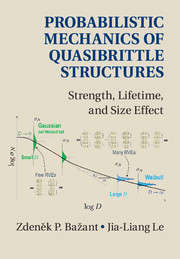Book contents
- Frontmatter
- Dedication
- Contents
- Foreword
- Preface
- 1 Introduction
- 2 Review of Classical Statistical Theory of Structural Strength and Structural Safety, and of Statistics Fundamentals
- 3 Review of Fracture Mechanics and Deterministic Size Effect in Quasibrittle Structures
- 4 Failure Statistics of Nanoscale Structures
- 5 Nano–Macroscale Bridging of Probability Distributions of Static and Fatigue Strengths
- 6 Multiscale Modeling of Fracture Kinetics and Size Effect under Static and Cyclic Fatigue
- 7 Size Effect on Probability Distributions of Strength and Lifetime of Quasibrittle Structures
- 8 Computation of Probability Distributions of Structural Strength and Lifetime
- 9 Indirect Determination of Strength Statistics of Quasibrittle Structures
- 10 Statistical Distribution and Size Effect on Residual Strength after Sustained Load
- 11 Size Effect on Reliability Indices and Safety Factors
- 12 Crack Length Effect on Scaling of Structural Strength and Type 1 to 2 Transition
- 13 Effect of Stress Singularities on Scaling of Structural Strength
- 14 Lifetime of High-k Gate Dielectrics and Analogy with Failure Statistics of Quasibrittle Structures
- Appendix A Power-Law Scaling of Boundary Value Problems
- Appendix B Proof of Transitional Size Effects of Types 1 and 2 by Dimensional Analysis and Asymptotic Matching up to Second Order
- Appendix C Proof of Small-Size Asymptotics of Cohesive Crack Model up to Second Order
- References
- Author Index
- Subject Index
Foreword
Published online by Cambridge University Press: 14 June 2017
- Frontmatter
- Dedication
- Contents
- Foreword
- Preface
- 1 Introduction
- 2 Review of Classical Statistical Theory of Structural Strength and Structural Safety, and of Statistics Fundamentals
- 3 Review of Fracture Mechanics and Deterministic Size Effect in Quasibrittle Structures
- 4 Failure Statistics of Nanoscale Structures
- 5 Nano–Macroscale Bridging of Probability Distributions of Static and Fatigue Strengths
- 6 Multiscale Modeling of Fracture Kinetics and Size Effect under Static and Cyclic Fatigue
- 7 Size Effect on Probability Distributions of Strength and Lifetime of Quasibrittle Structures
- 8 Computation of Probability Distributions of Structural Strength and Lifetime
- 9 Indirect Determination of Strength Statistics of Quasibrittle Structures
- 10 Statistical Distribution and Size Effect on Residual Strength after Sustained Load
- 11 Size Effect on Reliability Indices and Safety Factors
- 12 Crack Length Effect on Scaling of Structural Strength and Type 1 to 2 Transition
- 13 Effect of Stress Singularities on Scaling of Structural Strength
- 14 Lifetime of High-k Gate Dielectrics and Analogy with Failure Statistics of Quasibrittle Structures
- Appendix A Power-Law Scaling of Boundary Value Problems
- Appendix B Proof of Transitional Size Effects of Types 1 and 2 by Dimensional Analysis and Asymptotic Matching up to Second Order
- Appendix C Proof of Small-Size Asymptotics of Cohesive Crack Model up to Second Order
- References
- Author Index
- Subject Index
Summary
Failure of materials was recognized centuries ago as a critical component of structural mechanics and consequently of structural design. Efficient (minimum amount of materials) and economical (minimum cost) designs are based on the basic principle of taking full advantage of the strength of the materials used, while at the same time carefully avoiding any type of material failure.
Whether or not they were able to quantify it, adequately, engineers realized very soon that material failure involved a high level of uncertainty. Later on, based on advances in the mathematical theory of probability, researchers in the field of mechanics identified two basic types of material behavior as far as failure is concerned – ductile and brittle failures – and were able to establish rigorous probabilistic models for both. The Gaussian and Weibull probability distributions have been the standard models for these two types of material failure, respectively.
However, there has always been a transition area between ductile and brittle failures with a behavior that was orders of magnitude more complex and challenging to model: it has been named “quasibrittle behavior.” The two standard models for ductile and brittle failure were clearly not adequate in this transition area, and on top of that, there is a very wide range of materials falling in this category at the scale of laboratory testing and normal structures: concrete, various composites, toughened ceramics, many rocks, coal, ice, rigid foams, biological shells, bone, cartilage, dental ceramics, and many others. Furthermore, at the nano- and micrometer scales, virtually all materials become quasibrittle.
The first author of this book – one of the giants in the field of mechanics – has been instrumental over the years in developing a rigorous theoretical framework modeling the failures of structures made of quasibrittle materials. In a long series of seminal scientific papers, he has identified the challenges involved and has introduced a number of groundbreaking theories and models to address them. He and his coauthor, who, despite being much younger, has already impacted the field by his own seminal contributions, have provided in this volume the definitive treatment of this formidably challenging field, and in the process have established the complete theory of any type of material failure, ranging between the two limiting cases of ductile and brittle behaviors.
Information
- Type
- Chapter
- Information
- Probabilistic Mechanics of Quasibrittle StructuresStrength, Lifetime, and Size Effect, pp. xiii - xivPublisher: Cambridge University PressPrint publication year: 2017
